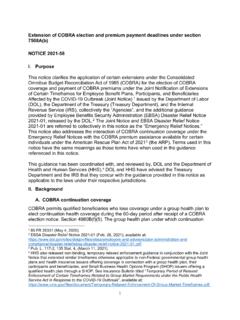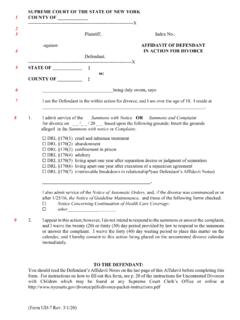Transcription of Medicare Secondary Payer Disability Introduction
1 Medicare Secondary Payer Disability Introduction Monday, April 4, 2022 Page 1 of 22 Medicare Secondary Payer Disability Introduction Slide 1 of 22 - Medicare Secondary Payer Disability Introduction Slide notes Welcome to the Electronic Correspondence Referral System Medicare Secondary Payer Disability course. Medicare Secondary Payer Disability Introduction Monday, April 4, 2022 Page 2 of 22 Slide 2 of 22 - Disclaimer Slide notes While all information in this document is believed to be correct at the time of writing, this Computer Based Training (CBT) is for educational purposes only and does not constitute official Centers for Medicare and Medicaid Services (CMS) instructions.
2 All affected entities are responsible for following the instructions found on the CMS Web site at the following link: CMS Website. Medicare Secondary Payer Disability Introduction Monday, April 4, 2022 Page 3 of 22 Slide 3 of 22 - Course Overview Slide notes This course will provide an overview on the MSP provisions of the Social Security Act for beneficiaries entitled to Medicare based on a Disability . It will provide guidelines in regard to employer size considerations, examples showing when Medicare would be Secondary Payer , and employer and Group Health Plan (GHP) guidelines. Medicare Secondary Payer Disability Introduction Monday, April 4, 2022 Page 4 of 22 Slide 4 of 22 - MSP Guidelines for Disability Slide notes The MSP provisions of the Social Security Act require GHPs to make payments before Medicare under certain circumstances.
3 Medicare is the Secondary Payer under the Disability provisions of MSP if all of the following conditions are met. First, the beneficiary must be under age 65 and on Medicare because of a Disability . Second, the insured person under the GHP must be either the beneficiary or family member. A family member is any individual covered by the GHP based upon current employment status. Third, the GHP coverage must be based upon the current employment status of the insured person. Fourth, the employer providing the GHP coverage must have 100 or more employees, or if the GHP is part of a multi-employer/multiple-employer plan, at least one of the employers in the multi-employer/multiple employer plan must employ 100 or more people. Medicare Secondary Payer Disability Introduction Monday, April 4, 2022 Page 5 of 22 Slide 5 of 22 - Medicare Beneficiary Under the Age of 65 Slide notes The first requirement we will examine is that the beneficiary must be under the age of 65 and be covered by Medicare because of a Disability .
4 Medicare entitlement commences after Social Security Disability benefits have been paid for 24 months. An exception to the 24-month rule occurs if the beneficiary suffers Amyotrophic Lateral Sclerosis, also known as ALS or Lou Gehrig s disease. Persons with ALS become entitled to Medicare the same month they start receiving Social Security Disability benefits. The Disability provisions of MSP cease to apply as of the first day of the month the beneficiary turns age 65. Note: When the beneficiary turns 65, he/she is considered enrolled in Medicare on the basis of age; therefore, the Working Aged MSP rules begin to apply. Medicare Secondary Payer Disability Introduction Monday, April 4, 2022 Page 6 of 22 Slide 6 of 22 - Insured Person is Beneficiary or Family Member Slide notes The second requirement is that the insured person under the GHP must be either the beneficiary or another family member.
5 This aspect of the Disability provisions of Medicare Secondary Payer is broader than that of the Working Aged provisions. Under the Working Aged provisions, the GHP policyholder must be the beneficiary or the spouse. A family member includes anyone who is covered on the basis of someone else s enrollment. Medicare Secondary Payer Disability Introduction Monday, April 4, 2022 Page 7 of 22 Slide 7 of 22 - Current Employment Status Slide notes The third requirement for Medicare to be the Secondary Payer under the Disability provisions, is that the insured person under the GHP must have current employment status with the employer that offers the GHP. A person entitled to Medicare on the basis of Disability has current employment status if the person fits the following criteria.
6 That person must be actively working as an employee, is the employer (including a self-employed person), or is associated with the employer in a business relationship. The person might also be the insured person, is not actively working and is receiving Disability benefits from an employer for up to 6 months. Note: the first 6 months of employer Disability benefits are subject to Federal Insurance Contributions Act (FICA) taxes. Lastly, the person might not be actively working but meets all of the following conditions on the next slide. Medicare Secondary Payer Disability Introduction Monday, April 4, 2022 Page 8 of 22 Slide 8 of 22 - Current Employment Status Slide notes If the insured person is not actively working, he/she must meet all the following conditions for Medicare to be the Secondary Payer under the Disability provisions.
7 The insured person must retain employment rights in the industry. The insured person must not have had his/her employment or employee organization membership terminated by the employer or employee organization if the employer or employee organization provides the coverage . The insured person must not be receiving Disability benefits from an employer for more than 6 months. The insured person must not be receiving Social Security Disability benefits, and finally, the insured person must have employment-based GHP coverage that is not Consolidated Omnibus Budget Reconciliation Act ( cobra ) continuation coverage . Medicare Secondary Payer Disability Introduction Monday, April 4, 2022 Page 9 of 22 Slide 9 of 22 - Employer Size Guidelines for Disability MSP Slide notes The final requirement for Medicare to be the Secondary Payer under the Disability provisions concerns employer size.
8 Under these provisions, Medicare is Secondary to the GHP benefits when a single employer employs 100 or more full-time and/or part-time employees, during 50 percent or more of its business days during the previous calendar year. The business days do not have to be consecutive, and an individual does not have to be working on a particular day in order to be counted as an employee. Medicare is Secondary to an employer s GHP that is not considered to be a multi or multiple-employer GHP. Medicare Secondary Payer Disability Introduction Monday, April 4, 2022 Page 10 of 22 Slide 10 of 22 - Single Employer 100 or More Employee Example Slide notes This slide illustrates how the 100 or more employee rule works.
9 Assume an employer employed 100 or more employees for more than 50 percent of its business days in 2006 and 2008. During 2007, the number of employees was fewer than 100 for over 50 percent of its business days. Medicare would be the Secondary Payer during calendar year 2007 because there were 100 or more employees on 50 percent or more of the business days in 2006. Medicare would be primary in 2008 because there were fewer than 100 employees during 2007. Medicare would again become Secondary for 2009 because the 100-employee threshold was satisfied in 2008. Medicare Secondary Payer Disability Introduction Monday, April 4, 2022 Page 11 of 22 Slide 11 of 22 - Multi-Employer/Multiple-Employer GHP Slide notes A multi-employer/multiple employer plan is defined as, any trust, plan, association or any other arrangement that is sponsored jointly by two or more employers or by employers and unions (as under the Taft-Hartley law), where they contribute, sponsor, directly provide health benefits, or facilitate, directly or indirectly the acquisition of health insurance by an employer member.
10 If such facilitation exists, the employer is a participant in a multi-employer/multiple employer GHP even if it has a separate contract with an insurer. Medicare Secondary Payer Disability Introduction Monday, April 4, 2022 Page 12 of 22 Slide 12 of 22 - Size Guidelines for a Multi-Employer/Multiple-Employer GHP Under Disability MSP Slide notes If the GHP is a multi-employer/multiple-employer plan, Medicare is Secondary for all individuals enrolled in the GHP or Prescription Drug Plan, as long as at least one of the employers meets the 100-or-more-employee requirement, ( , at least one employer employed 100 or more employees on 50% or more of its business days during the previous calendar year).












